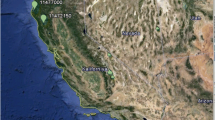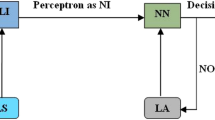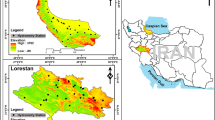Abstract
Suspended sediment load modeling through advanced computational algorithms is of major importance and a challenging topic for developing highly accurate hydrological models. To model the suspended sediment load in the Rampur watershed station in the Mahanadi River Basin, Chhattisgarh State, India, unique integrated computational intelligence regression models with an optimizer are proposed in this study. For the first time in the literature, the isotonic regression (ISO) and sequential minimal optimization regression (SMOR) models and their hybrid versions with an iterative classifier optimizer (ICO) are applied for suspended sediment load modeling. The research is based on daily discharge and suspended sediment data collected over a 38-year period (1976–2014). Root mean square error (RMSE), relative root mean square error (RRMSE), coefficient of determination (R2), and Nash–Sutcliffe efficiency (NSE) were employed to evaluate the performance of the standalone ISO and SMOR, as well as the proposed ICO–ISO and ICO–SMOR hybrid models. Ten different scenarios were considered for modeling to investigate the performance of the models using different input combinations. The proposed new models were found to be more reliable than standalone ISO and SMOR models. Results revealed that the performance of the hybrid model was mostly attributable to the basic algorithm for the model development, where both SMOR and ICO–SMOR models were superior to their ISO and ICO–ISO counterparts in terms of accurate computation. Overall, the ICO–SMOR models outperformed the other models in terms of accuracy, with RMSE, RRMSE, R2, and NSE of 5495.1 tons/day, 2.77, 0.90, and 0.86, respectively. The current study's findings support the applicability of the proposed methodology for modeling of suspended sediment load and encourage the use of these methods in alternative hydrological modeling.








Similar content being viewed by others
Data Availability
The datasets used and/or analyzed during the current study are available from the corresponding author on reasonable request.
References
Abebe, T., & Gebremariam, B. (2019). Modeling runoff and sediment yield of Kesem dam watershed, Awash basin, Ethiopia. SN Applied Science, 1, 446. https://doi.org/10.1007/s42452-019-0347-1
Achite, M., Yaseen, Z. M., Heddam, S., Malik, A., & Kisi, O. (2021). Advanced machine learning models development for suspended sediment prediction: Comparative analysis study. Geocarto International, 1–25.
Adnan, R.M., Liang, Z., El-Shafie, A., Zounemat-Kermani, M., Kisi, O. (2019). Prediction of Suspended Sediment Load Using Data-Driven Models. Water, 11, 2060. https://doi.org/10.3390/w11102060.
Adnan, R. M. R., Mostafa, R., Kisi, O., Yaseen, Z. M., Shahid, S., & Zounemat-Kermani, M. (2021). Improving streamflow prediction using a new hybrid ELM model combined with hybrid particle swarm optimization and grey wolf optimization. Knowledge-Based Systems, 230, 107379. https://doi.org/10.1016/j.knosys.2021.107379.
Adnan, R. M. R., Yaseen, Z. M., Heddam, S., Shahid, S., Sadeghi-Niaraki, A., & Kisi, O. (2022). Predictability performance enhancement for suspended sediment in rivers: Inspection of newly developed hybrid adaptive neuro-fuzzy system model. International Journal of Sediment Research, 37(3), 383–398.
Ahmadi, M., Minaei, M., Ebrahimi, O., et al. (2020). Evaluation of WEPP and EPM for improved predictions of soil erosion in mountainous watersheds: A case study of Kangir River basin, Iran. Modelling Earth System Environment, 6, 2303–2315. https://doi.org/10.1007/s40808-020-00814-w
Ampomah, R., Hosseiny, H., Zhang, L., Smith, V., & Sample-Lord, K. (2020). A regression-based prediction model of suspended sediment yield in the Cuyahoga River in Ohio using historical satellite images and precipitation data. Water, 12, 881. https://doi.org/10.3390/w12030881
Arekhi, S., Niazi, Y., & Kalteh, A. M. (2012). Soil erosion and sediment yield modeling using RS and GIS techniques: A case study, Iran. Arabian Journal of Geosciences, 5(2), 285–296. https://doi.org/10.1007/s12517-010-0220-4
Asres, M. T., & Awulachew, S. B. (2010). SWAT based runoff and sediment yield modelling: A case study of the Gumera watershed in the Blue Nile basin. Ecohydrology and Hydrobiology, 10(2–4), 191–199. https://doi.org/10.2478/v10104-011-0020-9
Borrelli, P., Robinson, D. A., Fleischer, L. R., Lugato, E., Ballabio, C., Alewell, C., & Bagarello, V. (2017). An assessment of the global impact of 21st century land use change on soil erosion. Nature Communications, 8(1), 1–13. https://doi.org/10.1038/s41467-017-02142-7
Bouzeria, H., Ghenim, A. N., & Khanchoul, K. (2017). Using artificial neural network (ANN) for prediction of sediment loads, application to the Mellah catchment, northeast Algeria. Journal of Water and Land Development, 33(IV–VI), 47–55.
Buyukyildiz, M., & Kumcu, S. Y. (2017). An estimation of the suspended sediment load using adaptive network based fuzzy inference system, support vector machine and artificial neural network models. Water Resources Management: an International Journal, Published for the European Water Resources Association (EWRA) Springer; European Water Resources Association (EWRA), 31(4), 1343–1359.
Chandra, P., Patel, P. L., Porey, P. D., & Gupta, I. D. (2014). Estimation of sediment yield using SWAT model for Upper Tapi basin. ISH Journal of Hydraulic Engineering. https://doi.org/10.1080/09715010.2014.902170
Chiang, J. L., & Tsai, Y. S. (2011). Suspended sediment load estimate using support vector machines in Kaoping river basin. In Consumer electronics, communications and networks (CECNet), international conference (pp. 1750–1753).
Christanto, N., Setiawan, M. A., Nurkholis, A., Istikhomah, S., Anajib, D. W., & Purnomo, A. D. (2019). Rainfall-runoff and sediment yield modeling in volcanic catchment using SWAT, a case study in Opak Watershed. IOP Conference Series: Earth and Environmental Science, 256, 012015. https://doi.org/10.1088/1755-1315/256/1/012015
Cimen, M. (2008). Estimation of daily suspended sediments using support vector machines. Journal Hydrological Sciences Journal, 53(3), 656–666. https://doi.org/10.1623/hysj.53.3.656
Doroudi, S., Sharafati, A., & Mohajeri, S. H. (2021). Estimation of daily suspended sediment load using a novel hybrid support vector regression model incorporated with observer-teacher-learner-based optimization method. Complexity. https://doi.org/10.1155/2021/5540284
Dutta, S., & Sen, D. (2018). Application of SWAT model for predicting soil erosion and sediment yield. Sustainable Water Resources Management, 4, 447–468. https://doi.org/10.1007/s40899-017-0127-2
Essam, Y., Huang, Y. F., Birima, A. H., Ahmed, A. N., & El-Shafie, A. (2022). Predicting suspended sediment load in Peninsular Malaysia using support vector machine and deep learning algorithms. Scientific Reports, 12(1), 1–29.
Gudino-Elizondo, N., Biggs, T. W., Bingner, R. L., Langendoen, E. J., Kretzschmar, T., Taguas, E. V., Taniguchi-Quan, K. T., Liden, D., & Yuan, Y. (2019). Modelling runoff and sediment loads in a developing coastal watershed of the US-Mexico border. Water, 11, 1024. https://doi.org/10.3390/w11051024
Harun, M. A., Safari, M. J. S., Gul, E., & Ab Ghani, A. (2021). Regression models for sediment transport in tropical rivers. Environmental Science and Pollution Research, 28(38), 53097–53115.
Hussian, M., Grimvall, A., Burdakov, O., & Sysoev, O. (2005). Monotonic regression for the detection of temporal trends in environmental quality data. MATCH Communication Mathematics Computational Chemistry, 54, 535–550.
Jothiprakash, V., & Garg, V. (2009). Reservoir sedimentation estimation using artificial neural network. Hydrologic Engineering, 14(9), 1035–1040. https://doi.org/10.1061/ASCEHE.1943-5584.0000075
Kim, B., Choi, S. Y., & Han, K. Y. (2019). Integrated real-time flood forecasting and inundation analysis in small-medium streams. Water, 11, 919. https://doi.org/10.3390/w11050919
Kisi, O. (2012). Modeling discharge-suspended sediment relationship using least square support vector machine. Journal of Hydrology, 456–457, 110–120.
Kisi, O., Dailr, A.H., Cimen, M., & Shiri, J. (2012). Suspended sediment modeling using genetic programming and soft computing techniques. Journal of Hydrology, 450–451, 48–58. https://doi.org/10.1016/j.jhydrol.2012.05.031.
Kisi O, Ozkan C (2017). A new approach for modeling sediment-discharge relationship: local weighted linear regression. Water Resources Management: An International Journal, Published for the European Water Resources Association (EWRA), Springer; European Water Resources Association (EWRA), 31(1):1–23.
Khosravi, K., Sartaj, M., Tsai Frank, T. C., Singh, V. P., Kazakis, N., Melesse, A. M., Prakash, I., Tien Bui, D., & Pham, B. H. (2018). A comparison study of DRASTIC methods with various objective methods for groundwater vulnerability assessment. Science of the Total Environment, 642, 1032–1049. https://doi.org/10.1016/j.scitotenv.2018.06.130.
Larson, M. D., SimicMilas, A., Vincent, R. K., & Evans, J. E. (2021). Landsat 8 monitoring of multi-depth suspended sediment concentrations in Lake Erie’s Maumee River using machine learning. International Journal of Remote Sensing, 42(11), 4064–4086.
Liu, Y., & Jiang, H. (2019). Sediment yield modeling using SWAT model: Case of Changjiang River Basin. IOP Conference Series: Earth and Environmental Science, 234, 012031. https://doi.org/10.1088/1755-1315/234/1/012031
Liua, Q. Q., Chena, L., Lia, J. C., & Singh, V. P. (2004). Two-dimensional kinematic wave model of overland-flow. Journal of Hydrology, 291, 28–41.
Meshram, S. G., Ghorbani, M. A., Deo, R. C., Kashani, M. H., Meshram, C., & Karimi, V. (2019). New approach for sediment yield forecasting with a two-phase feed forward neuron network-particle swarm optimization model integrated with the gravitational search algorithm. Water Resource Management, 33(7), 2335–2356. https://doi.org/10.1007/s11269-019-02265-0
Meshram, S.G., Singh, V.P., Kisi, O., Karimi, V., & Meshram, C. (2020). Application of artificial neural networks, support vector machine and multiple model- ANN to sediment yield prediction. Water Resource Management. https://doi.org/10.1007/s11269-020-02672-8
Meshram, S. G., Safari, M. J. S., Khosravi, K., & Meshram, C. (2021). Iterative classifier optimizer-based pace regression and random forest hybrid models for suspended sediment load prediction. Environmental Science and Pollution Research, 28(9), 11637–11649.
Misra, D., Oommen, T., Agarwal, A., Mishra, S. K., & Thompson, A. M. (2009). Application and analysis of support vector machine based simulation for runoff and sediment yield. Biosystems Engineering, 103, 527–535.
Mohammadi, B., Guan, Y., Moazenzadeh, R., & Safari, M. J. S. (2021). Implementation of hybrid particle swarm optimization-differential evolution algorithms coupled with multi-layer perceptron for suspended sediment load estimation. CATENA, 198, 105024.
Naderloo, L., Alimardani, R., Omid, M., Sarmadian, F., JavadikiaTorabi, M. Y., & Alimardani, F. (2012). Application of ANFIS to predict crop yield based on different energy inputs. Measurement, 45(6), 1406–1413.
Nagatsuka, H., Uchino, M., & Yamamoto, H. (2012). Parameter estimation of multivariate distributions under order restrictions of the parameters: An extension of isotonic regression. Quality Technology & Quantitative Management, 9(3), 283–293. https://doi.org/10.1080/16843703.2012.11673292.
Nicklow, J. W., Mays, L. W. (2000). Optimization of Multiple Reservoir Networks for Sedimentation Control. Journal of Hydraulic Engineering. https://doi.org/10.1061/(ASCE)0733-9429(2000)126:4(232)
Omondi, R. A., & Rajapakse, C. J. (2010). FPGA implementations of neural networks (1st edn.). Springer.
Patel, D., & Parekh, F. (2014). Flood forecasting using adaptive neuro-fuzzy inference system (ANFIS). International Journal of Engineering Trends and Technology (IJETT), 12(10), 510–514.
Pham, B. T., Prakash, I., Chen, W., Ly, H. B., Ho, L. S., Omidvar, E., Tran, V. P., & Bui, D. T. (2019). A novel intelligence approach of a sequential minimal optimization-based support vector machine for landslide susceptibility mapping. Sustainability, 11, 6323. https://doi.org/10.3390/su11226323
Platt, J. (1999). Fast training of support vector machines using sequential minimal optimization. In B. Sch¨olkopf, C. J. C. Burges, & A. J. Smola (Eds.), Advances in kernel methods—Support vector learning (pp. 185–208). Cambridge, MA: MIT Press.
Polucci, D., Marchetti, M., & Fiori, S. (2020). A novel non-isotonic statistical bivariate regression method—Application to stratigraphic data modeling and interpolation. Mathematics Computing Application, 25(1), 15. https://doi.org/10.3390/mca25010015
Safari, M. J. S. (2020). Hybridization of multivariate adaptive regression splines and random forest models with an empirical equation for sediment deposition prediction in open channel flow. Journal of Hydrology, 590, 125392. https://doi.org/10.1016/j.jhydrol.2020.125392
Safari, M. J. S., & Shirzad, A. (2019). Self-cleansing design of sewers: Definition of the optimum deposited bed thickness. Water Environment Research, 91(5), 407–416. https://doi.org/10.1002/wer.1037
Samadianfard, S., Kargar, K., Shadkani, S., Hashemi, S., Abbaspour, A., & Safari, M. J. S. (2022). Hybrid models for suspended sediment prediction: Optimized random forest and multi-layer perceptron through genetic algorithm and stochastic gradient descent methods. Neural Computing and Applications, 34(4), 3033–3051.
Samantaray, S., Sahoo, A., & Ghose, D. K. (2020). Assessment of sediment load concentration using SVM, SVM-FFA and PSR-SVM-FFA in arid watershed, India: A case study. KSCE Journal of Civil Engineering, 24, 1944–1957. https://doi.org/10.1007/s12205-020-1889-x
Schneider, W. (2018). On basic equations and kinematic-wave theory of separation processes in suspensions with gravity, centrifugal and Coriolis forces. Acta Mechanica, 229, 779–794. https://doi.org/10.1007/s00707-017-1998-x
Sharafati, A., Haji SeyedAsadollah, S. B., Motta, D., & Yaseen, Z. M. (2020b). Application of newly developed ensemble machine learning models for daily suspended sediment load prediction and related uncertainty analysis. Hydrological Sciences Journal. https://doi.org/10.1080/02626667.2020.1786571
Sharafati, A., Pezeshki, E., Shahid, S., & Motta, D. (2020a). Quantification and uncertainty of the impact of climate change on river discharge and sediment yield in the Dehbar river basin in Iran. Journal of Soils and Sediments, 20(7), 2977–2996. https://doi.org/10.1007/s11368-020-02632-0
Singh, H. V., Panuska, J., & Thompson, A. M. (2017). Estimating sediment delivery ratios for grassed waterways using WEPP. Land Degradation and Development. https://doi.org/10.1002/ldr.2727
Smola, A. J., & Schölkopf, B. (2004). A tutorial on support vector regression. Statistics and Computing, 14, 199–222. https://doi.org/10.1023/B:STCO.0000035301.49549.88
Talebizadeh, M., Morid, S., Ayyoubzadeh, S. A., et al. (2010). Uncertainty analysis in sediment load modeling using ANN and SWAT model. Water Resources Management, 24, 1747–1761. https://doi.org/10.1007/s11269-009-9522-2
Tiwari, S., Babbar, R., & Kaur, G. (2018). Performance evaluation of two ANFIS Models for predicting water quality index of River Satluj (India). Advance in Civil Engineering. https://doi.org/10.1155/2018/8971079
Tuset, J., Vericat, D., & Batalla, R. J. (2015). Rainfall, runoff and sediment transport in a Mediterranean mountainous catchment. Science of the Total Environment. https://doi.org/10.1016/j.scitotenv.2015.07.075
Ullaha, N., & Choudhury, P. (2010). Flood forecasting in river system using ANFIS. AIP Conference Proceedings, 1298, 694. https://doi.org/10.1063/1.3516407
Vaheddoost, B., Vazifehkhah, S., & Safari, M. J. S. (2022). A stochastic approach for the assessment of suspended sediment concentration at the Upper Rhone River basin, Switzerland. Environmental Science and Pollution Research, 29(26), 39860–39876.
Veni, S., & Srinivasan, A. (2020). Comparison of linear regression and isotonic regression analysis implemented for project management in software development life cycle. International Journal of Engineering Sciences and Research Technology, 6(12).
Yadav, A., Chatterjee, S., & Equeenuddin, S. M. (2018). Suspended sediment yield estimation using genetic algorithm-based artificial intelligence models: Case study of Mahanadi River, India. Hydrological Sciences Journal, 63(8), 1162–1182. https://doi.org/10.1080/02626667.2018.1483581
Yuan, X., Chen, C., Lei, X., Yuan, Y., & Muhammad Adnan, R. (2018). Monthly runoff forecasting based on LSTM-ALO model. Stochastic Environment Research Risk Assessment, 32(8), 2199–2212. https://doi.org/10.1007/s00477-018-1560-y
Acknowledgements
The authors extend their appreciation to the Deanship of Scientific Research at King Khalid University, Abha, Kingdom of Saudi Arabia for funding this work through small research groups under grant number RGP. 1/113/43. Special thanks to Mr. Behzad Shakouri from Urmia University for his help during the revision of the manuscript.
Funding
This research work was supported by the Deanship of Scientific Research at King Khalid University under Grant number RGP. 1/113/43.
Author information
Authors and Affiliations
Corresponding author
Ethics declarations
Conflicts of interest
The authors declare no conflicts of interest.
Code availability
None.
Ethics approval
Not applicable.
Consent to participate
Not applicable.
Consent for publication
All authors agree to publish.
Additional information
Publisher's Note
Springer Nature remains neutral with regard to jurisdictional claims in published maps and institutional affiliations.
Rights and permissions
Springer Nature or its licensor holds exclusive rights to this article under a publishing agreement with the author(s) or other rightsholder(s); author self-archiving of the accepted manuscript version of this article is solely governed by the terms of such publishing agreement and applicable law.
About this article
Cite this article
Safari, M.J.S., Meshram, S.G., Khosravi, K. et al. Suspended Sediment Modeling Using Sequential Minimal Optimization Regression and Isotonic Regression Algorithms Integrated with an Iterative Classifier Optimizer. Pure Appl. Geophys. 179, 3751–3765 (2022). https://doi.org/10.1007/s00024-022-03131-8
Received:
Revised:
Accepted:
Published:
Issue Date:
DOI: https://doi.org/10.1007/s00024-022-03131-8




